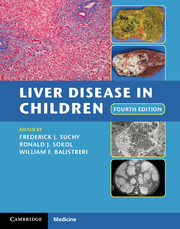Book contents
- Frontmatter
- Contents
- List of Contributors
- Preface
- Section I Pathophysiology of pediatric liver disease
- Section II Cholestatic liver disease
- Section III Hepatitis and immune disorders
- Section IV Metabolic liver disease
- Section V Other considerations and issues in pediatric hepatology
- Chapter 39 Bacterial, parasitic, and fungal infections of the liver
- Chapter 40 Systemic disease and the liver
- Chapter 41 Fibrocystic liver disease
- Chapter 42 Tumors of the liver
- Chapter 43 Liver transplantation in children: indications and surgical aspects
- Chapter 44 Liver transplantation in children: post-transplant care
- Index
- References
Chapter 40 - Systemic disease and the liver
from Section V - Other considerations and issues in pediatric hepatology
Published online by Cambridge University Press: 05 March 2014
- Frontmatter
- Contents
- List of Contributors
- Preface
- Section I Pathophysiology of pediatric liver disease
- Section II Cholestatic liver disease
- Section III Hepatitis and immune disorders
- Section IV Metabolic liver disease
- Section V Other considerations and issues in pediatric hepatology
- Chapter 39 Bacterial, parasitic, and fungal infections of the liver
- Chapter 40 Systemic disease and the liver
- Chapter 41 Fibrocystic liver disease
- Chapter 42 Tumors of the liver
- Chapter 43 Liver transplantation in children: indications and surgical aspects
- Chapter 44 Liver transplantation in children: post-transplant care
- Index
- References
Summary
Introduction
The liver is the largest parenchymal organ in the body and has the most complicated circulation of any organ, with dual afferent blood supply from the portal vein and hepatic artery. Although the liver mass accounts for only 2.5% of adult body weight, it receives nearly 25% of the resting cardiac output and at any given time contains 10–15% of total body blood volume. In addition to serving as an important blood volume reservoir, the liver is also a complex metabolic organ with important functions in biosynthesis, immunity, metabolism, and clearance. By virtue of its size, multiple metabolic functions, and prominent position in the circulatory system, the liver is frequently involved, either as an accomplice or as an innocent bystander, in a range of systemic, circulatory, and inflammatory disorders. This chapter reviews hepatic involvement in common childhood systemic diseases.
Hepatic dysfunction in the intensive care unit
Hepatic dysfunction, primarily manifest as jaundice, is a common occurrence in the intensive care unit, affecting up to one-third of non-cirrhotic adults [1]. The causes of “intensive care unit jaundice” are multifactorial and may reflect increased bilirubin production (hemolysis, gastrointestinal bleeding, and resorption of hematomas), decreased intrahepatic bilirubin processing (shock, pharmacologic effects, use of total parenteral nutrition), and/or decreased bilirubin excretion (sepsis, biliary obstruction). Severe shock (that requiring significant pressor support), sepsis, use of mechanical ventilation (positive end-expiratory pressure ventilation), and major surgery are independent risk factors for hepatic dysfunction in critically ill patients [1]. In low-flow and hypoxic states, the liver is at particular risk because selective splanchnic vasoconstriction will result in decreased inflow via the portal vein. Normally the hepatic artery buffer response can partially compensate for decreased portal flow; however, this is an energy-dependent process and becomes markedly less efficient with severe or prolonged hypoperfusion [2]. In addition, high-dose systemic vasopressors (dopamine, epinephrine, and norepinephrine) reduce total liver blood flow by up to 50% and decrease the ratio of hepatic oxygen supply to consumption, delivering a second hit to the liver.
- Type
- Chapter
- Information
- Liver Disease in Children , pp. 694 - 709Publisher: Cambridge University PressPrint publication year: 2014
References
- 1
- Cited by

